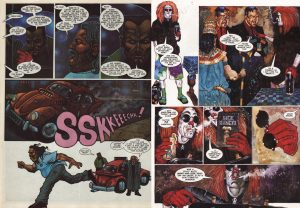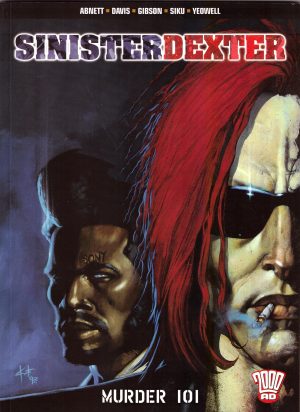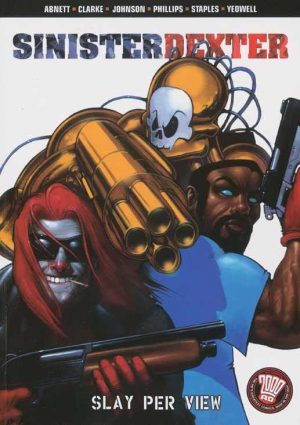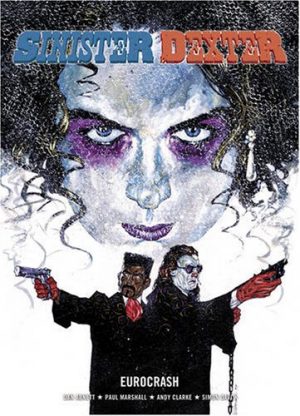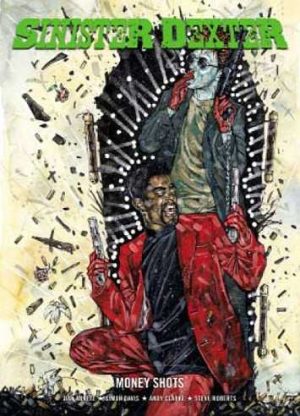Review by Frank Plowright
Finnigan Sinister and Ramone Dexter are gunsharks, assassins by any other name, operating in Downlode, which in the future is a massive urban sprawl covering most of mainland Europe. For reasons best known to the editor packaging the Sinister Dexter collections, they aren’t a complete series run, with some stories randomly missed out, but broadly speaking Gunshark Vacation collects most of 1996’s output, the feature’s first year.
From the start Dan Abnett ensures Sinister Dexter is a cultural melting pot, throwing in ideas from literature to trash, these early stories making much of Dexter’s inbuilt TV access as he zones out watching an assortment of unlikely old programmes. Abnett begins by establishing Sinister and Dexter, and although all but one story is restricted to two parts, he introduces a continuity, with Downlode’s crime boss Moses Tannenbaum increasingly featuring. Quentin Tarantino’s Pulp Fiction is one of the more obvious influences on a pair of talkative assassins with a formidable reputation. Despite this, as we see, Sinister and Dexter’s solid partnership is primarily one of adapting to problems when the kaka and the fan have meaningful intercourse, as Abnett so nicely phrases it. While it never descends into Carry On Killing, Abnett increasingly refines a sense of farce.
At 2000AD in the 1990s many artists painted their pages, but not very well, and Gunshark Vacation exemplifies this. David Millgate designed the lead characters and draws the first two stories, but his art is an acquired taste, with flat people at odd angles, his pages a fusion of Simon Bisley and Jamie Hewlett’s very different styles. Not that most of the following artists are much better. Anthony Williams and Tom Carney both work in the exaggerated style of the 1990s with awkward layouts and in Carney’s case a lot of work needed to reach professional standards, a triumph of style over technique. Charles Gillespie (sample spread left) draws three stories, and has a strong sense of design, but occasionally produces two-dimensional people. He improves by the episode, though, and it’s under him that Sinister and Dexter gradually evolve their settled appearance. Cementing that is Simon Davis (sample art right), Gunshark Vacation’s best artist, giving Downlode and other areas a solidity and someone else who improves by the episode.
Language is important. Although he quickly tones down Dexter’s Speedy Gonzales accent and Sinister’s broad Irish, Abnett revels in speech patterns, concocts consistently funny names, and enjoys playing around with the narrative captions. A funny tale of an accountant in an amusement park indicates how the stories themselves would improve (and has early art from Henry Flint), but what’s here already entertains, with the title story by some distance the best in the book. It’s not just down to Davis’ class act, but to Abnett having settled into the characters, and moving crime in Downlode to a more interesting place. Both creators return for Murder 101.

